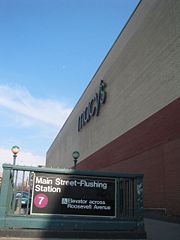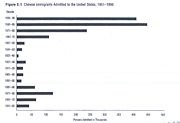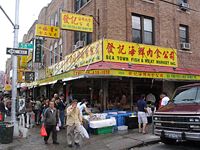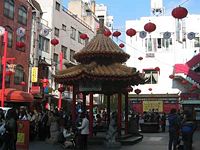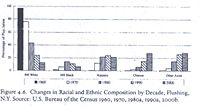From The Peopling of New York City
Contents |
Changes in the Ethnic Make-Up of Flushing.
Since the 1970’s “white flight”, Flushing, a once white middle class neighborhood, has undergone a tremendous transformation. Over the course of the 1980’s and 1990’s, the population of Flushing as well as that of New York in general has grown at alarming rates; at one point in this era, the rate of Flushing’s population growth was four times that of the rest of New York City. At the same time, there was a marked increase in the population of Chinese immigrants to the United States [1].
By the year 2000, Asians were the majority as measured by all but two aspects of census information. Although the data show an increase in all Asian populations in Flushing, the trend of the Chinese enclave is interesting in its connection to Manhattan’s Chinatown.
Why a new Chinatown ?
One may ask, if there was an influx of Chinese immigration to the City, why is there a creation of a new Chinatown? Flushing’s Chinatown is a relatively new development. It is one of the three neighborhoods in the City that are significant Chinese ethnic enclaves: Brooklyn’s newer Sunset Park and Manhattan’s more established downtown Chinatown are the other two ethnic enclaves (4).
This neighborhood has a relatively large amount of Taiwanese immigrants who speak Mandarin and thus, do not have much in common with the Cantonese-speaking majority living in Manhattan’s Chinatown [1].
Ethnic enclaves, like Flushing, help new immigrants assimilate into the United States. Since many immigrants know little or no English, these enclaves help newcomers by introducing them to services, etc. (3)
The following is an excerpt from an interview of a Chinese real estate agent from Flushing who works in the neighborhood’s Chinese community: (3)
- Our customers are exclusively Chinese, most of whom are immigrants and speak very little English. They want to buy or rent a house, but they don't know how and where. They come to us, and we provide them with all the necessary information and help in every step to their satisfaction. We deal with our customers in Chinese and in ways that they are familiar with. (Pers. interview, Sept. 1988)
Simply put, Flushing has a Chinatown distinct from Manhattan’s Chinatown because the cultural make up is vastly different. Since the purpose of an ethnic enclave is to bring those from the same culture together, it makes sense that a new Chinatown has formed.
Immigrants, Home Ownership in Ethnic Enclaves.
As a neighborhood with a very large percentage of immigrants, Flushing has a lower percentage of homeowners than the rest of the City . A Chinese resident of Chinatown describes, what he believes is the ideal housing situation for most of New York’s Chinese community (3).
- […] the neighborhood has to be safe with a good mix of ethnic groups. The Chinese prefer to live in a neighborhood with at least a Chinese family, some Asians, and maybe some Hispanics. People used to joke that the Chinese had a herd instinct; they were inclined to herd around their own folks. They don't want to be the first ones to move into a non-Chinese neighborhood, but as soon as one makes such a move, others will follow. There is rarely such a thing as just one Chinese family in a neighborhood. (Pers. interview, Sept. 1988)
The Role of Immigrants in Flushing Chinatown’s Economy
The following is an excerpt from an interview of a Chinese resident from Chinatown (3).
- Chinese immigrants have some essential preferences concerning where they would like to live. […] The location has to be convenient - near the subway lines, for many of the immigrants work in Chinatown and the subway is their only means of transportation. (Pers. interview, Sept. 1988)
There is evidence to prove that, as stated in the interview, a significant portion of Flushing’s Chinese population does travel to Manhattan Chinatown for work (3).
However, there is also evidence that Chinese immigrants who live in the outer boroughs are less likely to work in Manhattan Chinatown than those who actually live in that neighborhood (4) Thus, Flushing is not purely a dormitory neighborhood. In other words, there are a significant amount of Chinese businesses in Flushing, and the Chinese population of Flushing does contribute significantly to the economy of the neighborhood.
References.
- ↑ 1.0 1.1 Zhou, Min. Chinese: Divergent Destinies in Immigrant New York. New Immigrants in New York. Ed: Foner, Nancy. New York: Columbia University Press, 2001.
1. (Flushing)
2. (Chinese Divergent Destinies)
3. (In and out)
4. (Returns).
